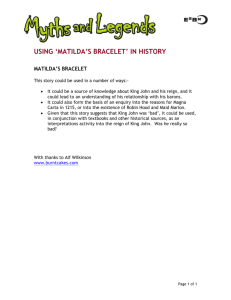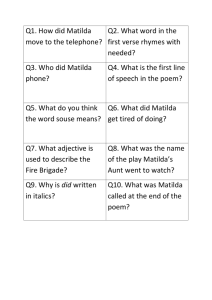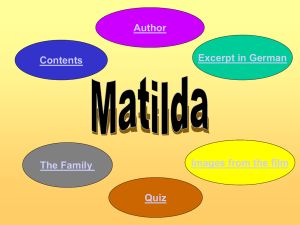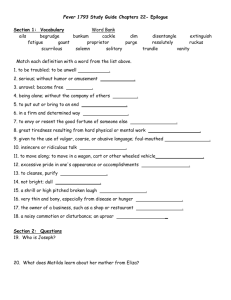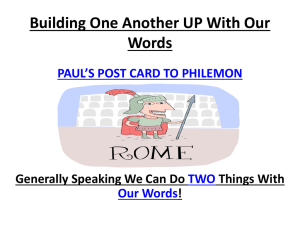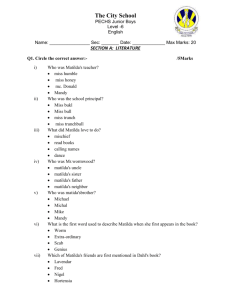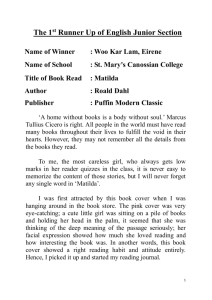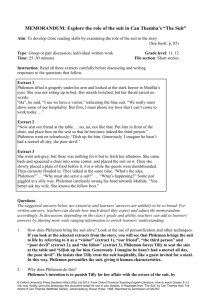Short Stories
advertisement
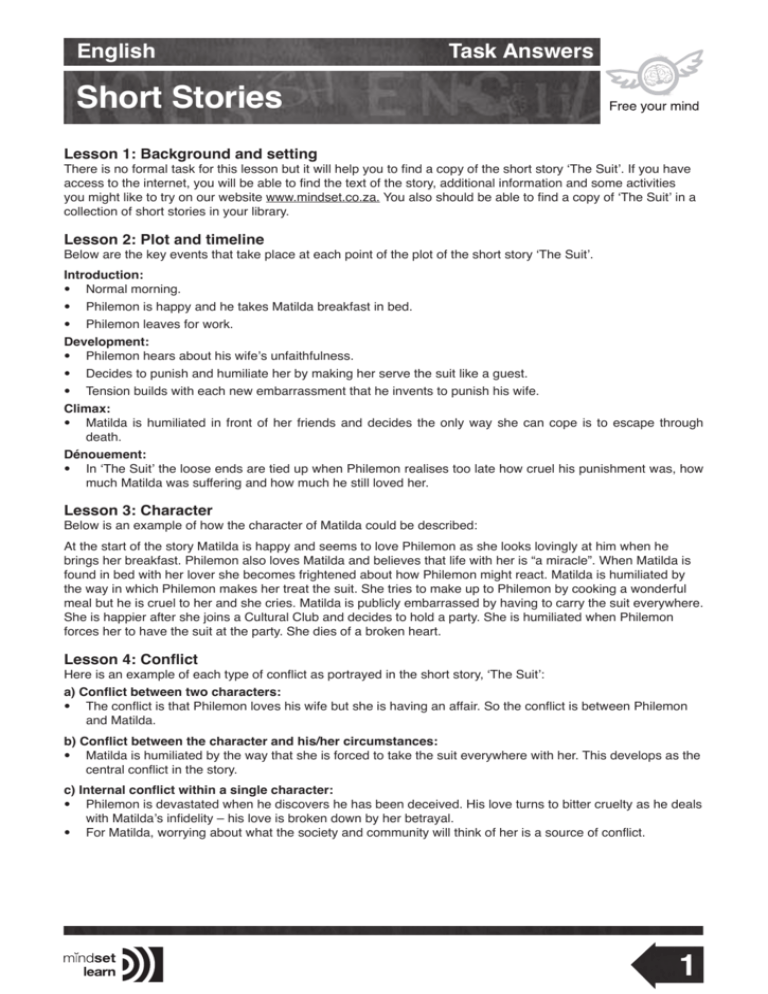
English Task Answers Short Stories Teacher Guide Lesson 1: Background and setting There is no formal task for this lesson but it will help you to find a copy of the short story ‘The Suit’. If you have access to the internet, you will be able to find the text of the story, additional information and some activities you might like to try on our website www.mindset.co.za. You also should be able to find a copy of ‘The Suit’ in a collection of short stories in your library. Lesson 2: Plot and timeline Below are the key events that take place at each point of the plot of the short story ‘The Suit’. Introduction: • Normal morning. • Philemon is happy and he takes Matilda breakfast in bed. • Philemon leaves for work. Development: • Philemon hears about his wife’s unfaithfulness. • Decides to punish and humiliate her by making her serve the suit like a guest. • Tension builds with each new embarrassment that he invents to punish his wife. Climax: • Matilda is humiliated in front of her friends and decides the only way she can cope is to escape through death. Dénouement: • In ‘The Suit’ the loose ends are tied up when Philemon realises too late how cruel his punishment was, how much Matilda was suffering and how much he still loved her. Lesson 3: Character Below is an example of how the character of Matilda could be described: At the start of the story Matilda is happy and seems to love Philemon as she looks lovingly at him when he brings her breakfast. Philemon also loves Matilda and believes that life with her is “a miracle”. When Matilda is found in bed with her lover she becomes frightened about how Philemon might react. Matilda is humiliated by the way in which Philemon makes her treat the suit. She tries to make up to Philemon by cooking a wonderful meal but he is cruel to her and she cries. Matilda is publicly embarrassed by having to carry the suit everywhere. She is happier after she joins a Cultural Club and decides to hold a party. She is humiliated when Philemon forces her to have the suit at the party. She dies of a broken heart. Lesson 4: Conflict Here is an example of each type of conflict as portrayed in the short story, ‘The Suit’: a) Conflict between two characters: • The conflict is that Philemon loves his wife but she is having an affair. So the conflict is between Philemon and Matilda. b) Conflict between the character and his/her circumstances: • Matilda is humiliated by the way that she is forced to take the suit everywhere with her. This develops as the central conflict in the story. c) Internal conflict within a single character: • Philemon is devastated when he discovers he has been deceived. His love turns to bitter cruelty as he deals with Matilda’s infidelity – his love is broken down by her betrayal. • For Matilda, worrying about what the society and community will think of her is a source of conflict. English Task Answers Short Stories Teacher Guide Lesson 5: Language, speech and dialogue a) An albatross is a large sea bird. b) The albatross is used in a famous poem by Samuel Taylor Cooleridge called “The Rhyme of the Ancient Mariner”. In this poem, the albatross is seen by sailors as a bird that brings good luck. In the poem the mariner (sailor), kills an albatross for no reason. The other sailors punish him by making him carry the dead bird around his neck. So the albatross is a symbol of bearing a terrible burden, just as Matilda has to bear the burden of carrying the suit to pay for her crime of having an affair. Lesson 6: Mood and atmosphere a) The words in bold help to describe Philemon’s mood. The bus ride home was a torture of numb dread and suffocating despair. Though the bus was now emptier Philemon suffered crushing claustrophobia. Then the wild swaying of the bus as it negotiated Mayfair Circle hurtled him sickeningly from side to side. Some of the younger women shrieked delightedly to the driver, “Fudugal!…Stir the pot!” as he swung his steering wheel this way and that. Normally, the crazy tilting of the bus gave him a prickling exhilaration. But now… These words show us that Philemon is anxious about going home and scared about what he will find when he gets there. He feels physically sick as he is so upset. He also feels as if he is trapped on the bus because it is taking him what feels like a long time to get home. b) The young woman are happy and excited, they provide a contrast to Philemon’s mood. Lesson 7: Narrative voice First person narrator Omniscient narrator Examples of pronouns used by narrator I, me, my, mine What narrator tells us Tells story as if it’s happening right now. He, him, his, she, her, hers, they, them, their, theirs Effect created by narrator Reader feels part of action. Definition Tells story from own point of view. Means all-knowing or knows everything. Has god-like knowledge. Narrator knows everything and so is infallible. Inside characters’ heads. Distance reader from character and so allow criticism. Can invite intimacy, allow reader to identify with character. English Task Answers Short Stories Teacher Guide Lesson 8: Themes and messages Here are definitions for important terms that are used to describe literature: Character: A character is a person in a text such as a book, play or film. Setting: The place in which the story takes place. In this case, the setting is Sofiatown in the 1950s. Plot: The events that occur in a story, or what happens in the story. Atmosphere: Mood/atmosphere describes the feeling of a place or situation. It creates a feeling in the reader about the kind of story it is; develops the characterisation; heightens the impact. Conflict: The disagreement, differences or confrontation between two characters, the character and his/her circumstances or within a single character. Context: Characterisation, setting, plot, atmosphere, conflict and language derive their meaning within the context of the story. In other words a suit on its own is an item of clothing, but within the setting of the story it becomes a symbol of betrayal and abuse.
